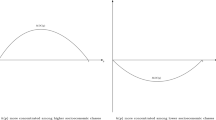Abstract
The article demonstrates that the dominance approach—often used for the measurement of welfare in a population in which there are different household types (see e.g., Atkinson and Bourguignon, Arrow and the foundations of the theory of economic policy, 350–370, 1987)—can be based on explicit value judgments on the households’ living standard. We define living standard by equivalent income (functions) and consider classes of inequality averse social welfare functions: Welfare increases if the inequality of living standard is decreased. In this framework, we suggest three new dominance criteria and obtain characterizations of second degree stochastic dominance and of two criteria proposed by Bourguignon (Journal of Econometrics 42:67–80, 1989).
Similar content being viewed by others
References
Atkinson, A., & Bourguignon, F. (1982). The comparison of multi-dimensioned distributions of economic status. Review of Economic Studies, 49, 183–201.
Atkinson, A. B., & Bourguignon, F. (1987). Income distribution and differences in needs. In G. R. Feiwel (Ed.), Arrow and the foundations of the theory of economic policy (pp. 350–370). London: Macmillan.
Bourguignon, F. (1989). Family size and social utility. Income distribution dominance criteria. Journal of Econometrics, 42, 67–80.
Buhmann, B., Rainwater, L., Schmaus, O., & Smeeding, T. M. (1988). Equivalence scales, well-being, inequality, and poverty: Sensitivity estimates across ten countries using the Luxembourg Income Study (LIS) database. Review of Income and Wealth, 34, 115–142.
Coulter, F. A. E., Cowell, F. A., & Jenkins, S. P. (1992). Equivalent scale relativities and the extent of inequality and poverty. Economic Journal, 102, 1067–1082.
Donaldson, D., & Pendakur, K. (2004). Equivalent-expenditure functions and expenditure-dependent equivalence scales. Journal of Public Economics, 88, 175–208.
Duclos, J.-Y., Sahn, D. E., & Younger, S. D. (2006). Robust multidimensional poverty comparisons. Economic Journal, 116, 943—968.
Ebert, U. (1997). Social welfare when needs differ: An axiomatic approach. Economica, 64, 233–244.
Ebert, U. (2000a). Sequential generalized Lorenz dominance and transfer principles. Bulletin of Economic Research, 52, 113–122.
Ebert, U. (2000b). Equivalizing incomes: A normative approach. International Tax and Public Finance, 7, 619–640.
Ebert, U. (2008). Living standard, social welfare and the redistribution of income in a heterogeneous population. Journal of Public Economic Theory, 10, 873–889.
Ebert, U., & Moyes, P. (2009). Household decisions and equivalence scales. Journal of Population Economics (forthcoming).
Fleurbaey, M., Hagneré C., & Trannoy, A. (2003). Welfare comparisons with bounded equivalence scales. Journal of Economic Theory, 110, 309–336.
Lambert, P., & Ramos, X. (2002). Welfare comparisons: Sequential procedures for heterogeneous populations. Economica, 69, 549–562.
McCaig, B., & Yatchew, A. (2007). International welfare comparisons and nonparametric testing of multivariate stochastic dominance. Journal of Applied Econometrics, 22, 951–969.
Ok, E. A., & Lambert, P. (1999). On evaluating social welfare by sequential Lorenz dominance. Economics Letters, 63, 45–53.
Ooghe, E. (2007). Sequential dominance and weighted utilitarianism. Economics Letters, 94, 208–212.
Ooghe, E., & Lambert, P. (2006). On bounded dominance criteria. Mathematical Social Sciences, 52, 15–30.
Shorrocks, A. F. (2004). Inequality and welfare evaluation of heterogeneous income distribution. Journal of Economic Inequality, 2, 193–218.
Author information
Authors and Affiliations
Corresponding author
Rights and permissions
About this article
Cite this article
Ebert, U. Dominance criteria for welfare comparisons: using equivalent income to describe differences in needs. Theory Decis 69, 55–67 (2010). https://doi.org/10.1007/s11238-009-9140-8
Received:
Accepted:
Published:
Issue Date:
DOI: https://doi.org/10.1007/s11238-009-9140-8



